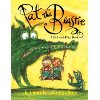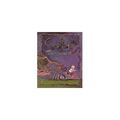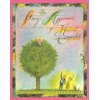21 Jul Telluride Gallery of Fine Art: Drescher in show of top children's book illustrators
 "I like the idea that books have a life of their own after they're published, making their way into people's lives and weaving connections between myself and the readers."
"I like the idea that books have a life of their own after they're published, making their way into people's lives and weaving connections between myself and the readers."
Who imagines a world in which a pudge triumphs and keeping up with the Joneses proves to be a deadly game? Or drawings in an unfinished book come to life and attack their creator, a young boy? Which inventor fashioned a "perpetual emotion machine?" Welcome to the amusing and edgy world of Henrik Drescher.
 Henrik Dreschler is one of 10 world-class children's book illustrators featured in an upcoming show at the Telluride Gallery of Fine Art. The exhibition, "From Beasts to Babar," the brainchild of gallery owner Will Thompson, opens July 28 and runs through early September.
Henrik Dreschler is one of 10 world-class children's book illustrators featured in an upcoming show at the Telluride Gallery of Fine Art. The exhibition, "From Beasts to Babar," the brainchild of gallery owner Will Thompson, opens July 28 and runs through early September.
Henrik Drescher was born in Copenhagen, but immigrated to America with his family in 1967. After one semester, he quit the School of the Museum of Fine Arts in Boston to begin a career in illustration. He also went out on the road, traveling throughout the United States, Mexico, and Europe, keeping journals of notes and drawings that revealed early on masterly graphic skills and an unfiltered, unruly imagination.
 Drescher’s editorial illustrations appear regularly in The New York Times, The Washington Post, Newsweek, Time, and Rolling Stone. He has also written and illustrated several books, including books for children, which he has been making since 1981. Drescher's books are held in the permanent collections of the Library of Congress, the Museum of Modern Art, the Victoria and Albert Museum, and the Rijks Museum in Den Haag, Netherlands.
Drescher’s editorial illustrations appear regularly in The New York Times, The Washington Post, Newsweek, Time, and Rolling Stone. He has also written and illustrated several books, including books for children, which he has been making since 1981. Drescher's books are held in the permanent collections of the Library of Congress, the Museum of Modern Art, the Victoria and Albert Museum, and the Rijks Museum in Den Haag, Netherlands.
Henrik Drescher now lives in China, so a phone interview was not an option. Instead read his answers to our questions.
Q & A
SV: Did you begin life as an artist. Or did life just end up that way?
HD: Everyone starts as an artist, some stop around puberty others continue.
SV: How would you describe your illustrative style?
HD: I like collecting and collaging, I also love line. And get a kick out of the simple act of making marks.
SV: Tell me something about what goes into creating your books. Just how laborious is the process? I believe you incorporate a variety of mediums from pen-and-ink, watercolor, photocollage, typography, die-cut, etc. How much of your work is created by hand versus online?
HD: Books are a long process. The ideas can simmer for many years before floating to the surface. Sometimes I work on the text first; other times I approach the story from a purely visual angle and add text afterwards. The ' style' of the art work is my final decision. I usually try to come up with a visual approach which suits the subject matter and at the same time will keep me interested. I feel that art for children's books should not talk down to the readers. Rather my aim is that my work operates on a high level visually, supporting the text without directly 'illustrating' it word for word.
SV: Of the approximately 36 children's books you have written, how many went mainstream?
If none, do you mind if collectors of your books are part of an exclusive club?
HD: "Simon's Book" and "Pat the Beastie" are the books that have sold the most copies. "Simon's Book" was featured on Reading Rainbow which was a great sales boost. "Pat the Beastie" was quite popular when it was originally published in the early 90's, and it has since been re-issued by Workman Press and I am to follow it up with a second "Beastie" book called "Love the Beastie,'" which will come out this Fall. I'm really happy with the result of this book, and in some ways I think it is a stronger work than the original.
In general I believe some of the best things happen in the periphery, and therefore I'm not worried about my books being part of an 'exclusive club' as you call it, however, I don't strive for them to be obscure or exclusive.
SV: Do ideas come to you easily and quickly? And where do they come from? Do you simply grab them from the zeitgeist? The headlines?
HD: I think the creative process is a non-stop involvement. Like most artists, I keep notebooks and am always communicating with my muse.
SV: Of all the books you have created, do you have a favorite story?
HD: I'd have to say "Simon's Book" and the "Strange Appearance of Howard Cranebill," but I'm also happy with "McFig and McFly."


Sorry, the comment form is closed at this time.